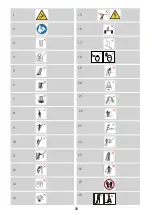
f)
make sure that the ladder is suitable for the
respective application.
g)
do not use damaged ladders
h)
remove all contaminants on the ladder, such
as wet paint, dirt, oil or snow
i)
before using a ladder at work, a risk
assessment should be carried out taking into
account the legislation in the country of use.
Very important:
a)
Do not exceed the maximum payload of each
type of ladder;
b)
do not lean too far; users should hold their
belt buckle (the navel) between the bars and
stand with both feet on the same step/glazing bar;
c)
do not climb away from a ladder without
additional safety glazing bar at a higher
altitude, for example, attachment or use of
a suitable device for safety glazing bar of
stability;
d)
ladders are not used to ascend to another level;
e)
the top three steps/glazing bar of a leaning
ladder do not use as stand area;
f)
the top two steps/glazing bar of a ladder step
without platform and device do not use for hand/
knee as stand area;
g)
ladders should only be used for light work of
short duration;
h)
by using non-conductive ladders for
unavoidable work under electric voltage;
i)
the ladder is not used outdoors in adverse
weather conditions, for example, strong wind
j)
Take precautionary measures so that no
children play on the ladder
k)
Lock doors (but not emergency exits) and
windows in the work area, if possible
l)
climb up and dismount the ladder with your
face to it
m)
hold the ladder firmly while climbing and
descending
n)
do not use the ladder as a bypass
o)
wear suitable shoes when climbing onto the
ladder
p)
avoid excessive lateral loads, for example,
when drilling in masonry and concrete
q)
Do not stay on the ladder for too long without
approx. 1:4), rungs or horizontal appearances
and complete opening of a ladder support
b)
Locking devices, if fitted, must be fully
secured before use
c)
the ladder must stand on a level, horizontal
and immovable surface
d)
a ladder should be leaned against a flat, firm
surface and secured before use, for example, by
attachment or use of suitable means to ensure
stability
e)
the ladder must never be moved from above
to a new position
f)
when the ladder is put into position, the risk of
a collision must be taken into account, for
example, with people, vehicles or doors. Lock
doors (but not emergency exits) and windows in
the work area, if possible
g)
Detect all risks posed by electrical equipment
in the work area. As high-voltage overhead
lines or other exposed electrical equipment
h)
the ladder must be placed on its feet, not on
the glazing bars or steps;
i)
the ladders must not be placed on slippery
surfaces (for example, ice, bare surfaces or
clearly contaminated solid surfaces), unless
more measures prevent the ladder from slipping
or that the contaminated areas are sufficiently
clean.
Pay special attention
a)
Are you in a position to use the ladder? Certain
health conditions, medication, alcohol or drug
abuse can lead to a risk to safety when using the
ladder
b)
when transporting ladders on roof racks or in
a truck to prevent signs of damage, ensure that
they are sufficiently fastened / attached
c)
Check the ladder after the delivery lazing bar
and before the first use, to determine the status
and function of all parts
d)
Visual inspection of the ladder for damage
and safe use at the beginning of each working
day, on which the ladder must be used.
e)
for commercial users, a periodic review is
required.
37
Содержание EVO-PROSTEP
Страница 1: ...DK NL UK FR DE RO PL NO ES I T...
Страница 2: ...1...
Страница 3: ...10 mm 2...
Страница 4: ...3 D C A1 B1 B2 A2 1...
Страница 5: ...4 F E 2...
Страница 6: ...5 G H 1 2 3 4 3...
Страница 7: ...max 150 kg 6...

































